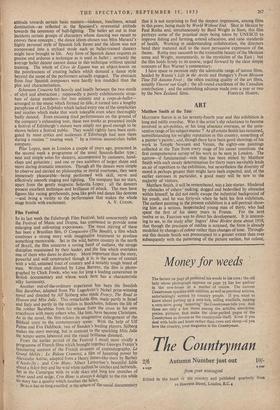Film Festival
IN its last week the Edinburgh Film Festival, held concurrently with the Festival of Music and Drama, has continued to provide some enlarging and enlivening experiences. The most stirring of these has been a Brazilian film, 0 Congaceiro (The Bandit), a film which combines a strong story with imaginative treatment to produce something memorable. Set in the wild, barren country in the north of Brazil, the film concerns a roving band of outlaws, the savage discipline maintained by their leader, and ,the fate which overtakes one of them who dares to disobey. More important than the story, powerful and well constructed though it is, is the sense of contact with a wild, untamed tract of country and a notably tough breed of men. Written and directed by Lima Barreto, the film is photo- graphed by Chick Fowle, who was for long a leading cameraman in British documentary and whose work here has a characteristic silky luminosity. Another out-of-the-ordinary experience has been the Swedish film Barabbas, adapted from Par Lagerkvist's Nobel prize-winning novel and directed by Alf Sjoberg who made Frenzy, The Road to Heaven and Miss Julie. This remarkable film, made partly in Israel and Italy and partly in the studios in Stockholm, follows the life of the robber Barabbas from his release from the cross to his own crucifixion with many others who, like him, have become Christians. As in the novel, the film relates its imaginative enlargement of the Biblical story to the contemporary scene. With the help of Ulf Palme and Eva Dahlbeck, two of Sweden's leading players, Sjoberg makes the story moving, but in contrast to the sparkling Miss Julie the tempo seems laboured and the visual brilliance dimmed. From the earlier period of the Festival I recall most vividly a programme of French films which brought together Georges Franju's fascinating account of the French inventor of cinematography, Le Grand Melies ; Le Rideau Cramoisi, a film of haunting power by Alexandre Astruc, adapted from a Henry James-like story by Barbey d'Aurevilly ; and Crin Blanc., Albert Lamorisse's beautiful fable about a fisher-boy and the wild white stallion he catches and befriends. Set in the Camargue with its wide skies and long low stretches of silver sand and sedge, Crin Blanc is always a delight to the eye while its story has a quality which touches the heart. 13rita,n has so long excelled ,11 the sphere of the social documentary that it is not surprising to find the deepest impression, among films in thii genre, being made by World Without End. Shot in Mexico by Paul Rotha and, simultaneously by Basil Wright in Siam, this film portrays some of the practical steps being taken by UNESCO to improve fishing and farming, extend education, and raise standards of health. Working in understanding collaboration, the directors bend their matured skill to the most persuasive expression of the theme. Rotha may succumb to the irresistible beauty of the Mexican scene and Wright, momentarily, to the mysticism of the East ; but the film holds firmly to its course, urged forward by the clear simple, concepts of Rex Warner's commentary.
I have space to mention only the admirable range of nature films, headed by Russia's Life in the Arctic and Hungary's From Blossom Time Till Autumn Frost ; the often exciting quality of the art films, notably Vincent van Gogh ; the all-round excellence of the Canadian contribution • and the astonishing advance made over a year or two


































 Previous page
Previous page